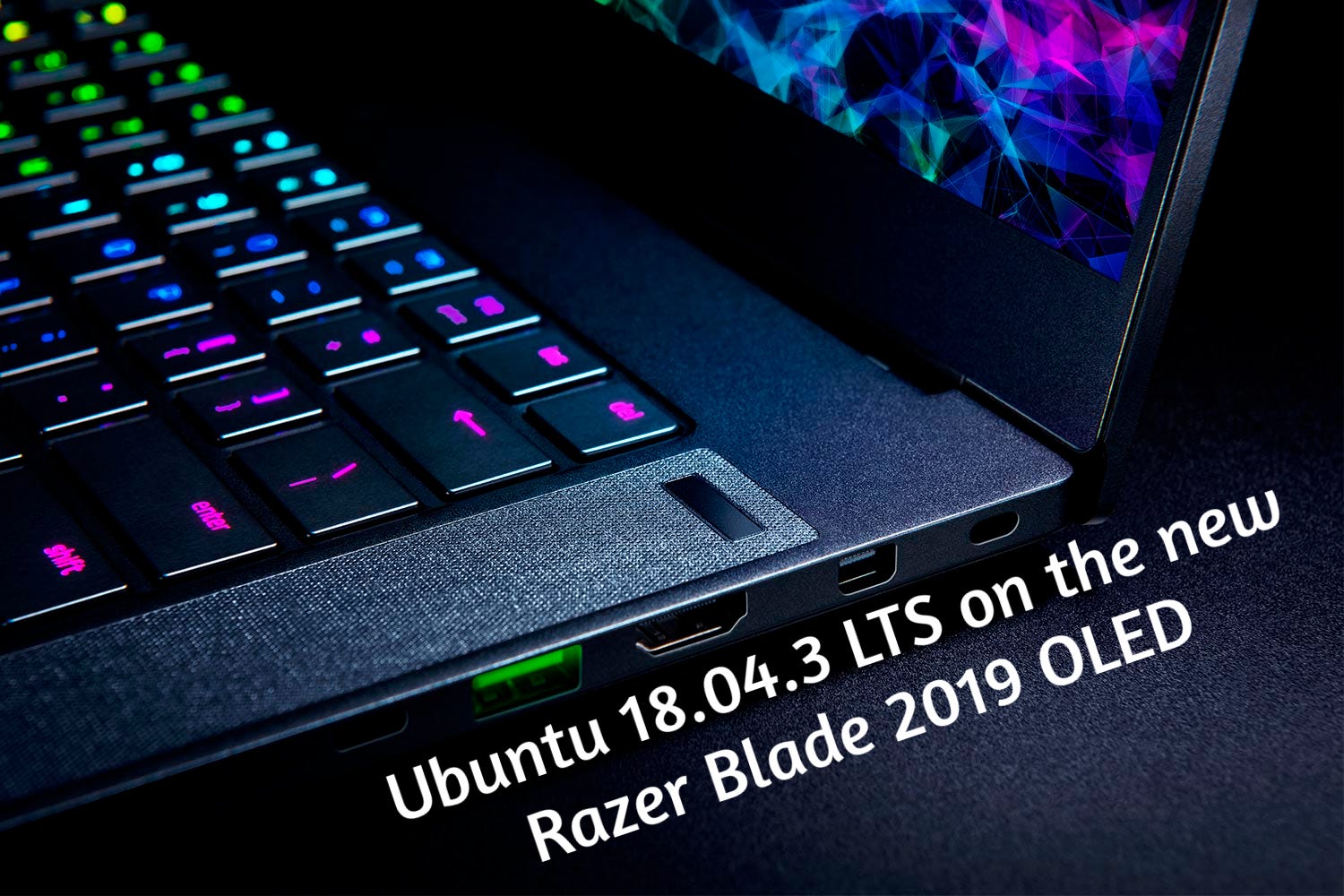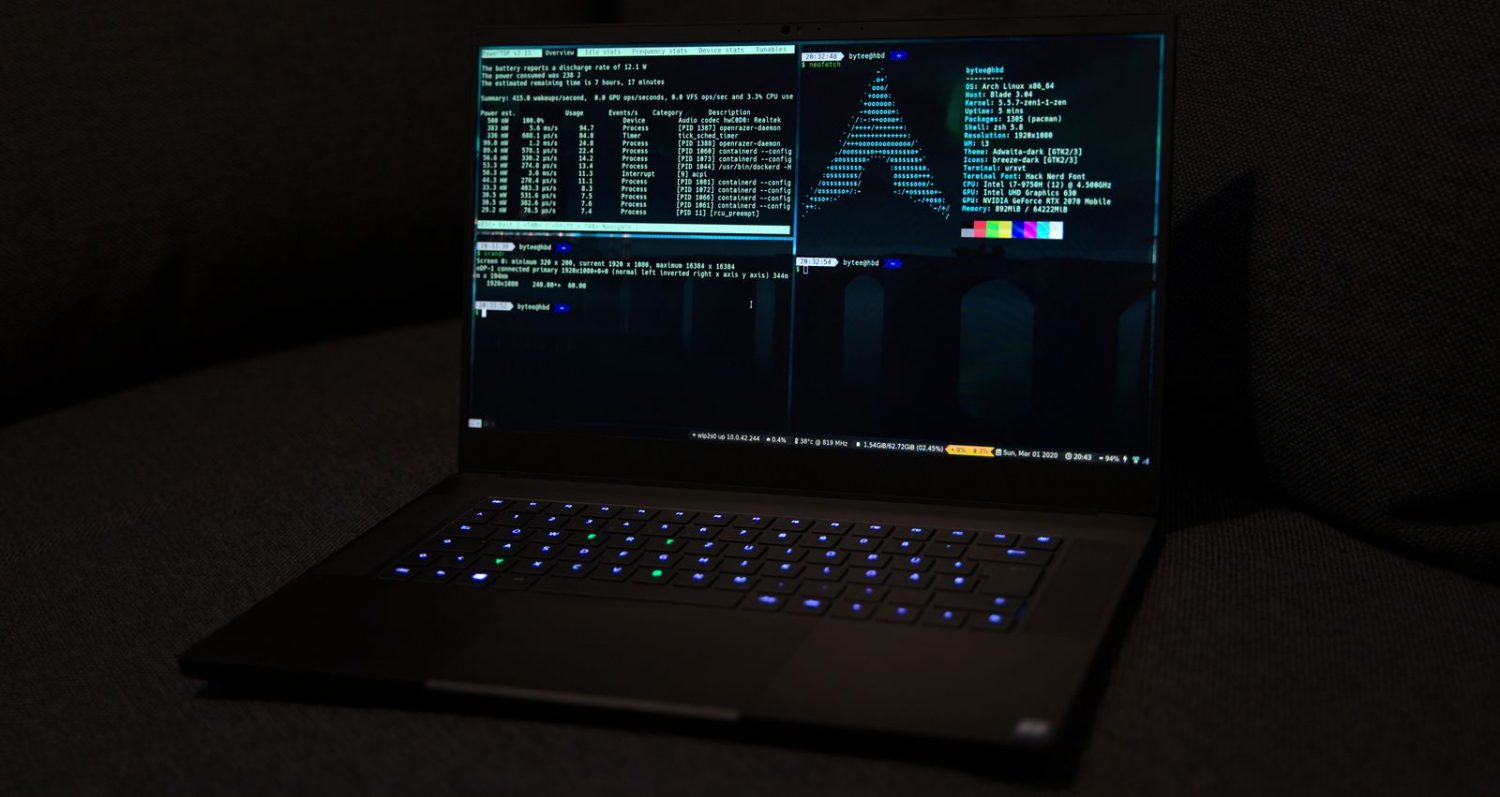Linux On Razer Blade
tl;dr The Razer Blade 2015 is a great portable gaming workstation. After months of research, tweaking, and ironing out the kinks, I’ve found that Linux Mint runs beautifully. The only problem still unresolved is an issue with the internal webcam.
Prologue
The Razer Blade 15 is the newest laptop made by Razer. This post will outline the steps I took to install and configure Linux Mint on my Razer Blade 15. TL;DR Once you've installed Linux Mint, clone this repository and run the auto-install.sh script to download and configure my preferred helper tools and settings. Razer Blade Stealth Linux Razer Blade Stealth (late 2016, Intel 7500U, UHD / HiDPI) Linux Ubuntu & Arch setup, including Razer Core with discrete NVIDIA GPU setup connected via thunderbolt. This page is available as Github Page Contact me at twitter @rolandguelle for questions or open an issue. The 2016 Razer Blade is a fantastic laptop with cutting edge hardware in a great form factor. The cutting edge, of course, is the problem for people trying to run Linux on this system and has prevented many from being able to get up and running at all. The Arch Linux installation is straightforward for the Razer Blade 15. Just disable Secure Boot in the Bios (Del Key) before installing and boot in UEFI mode. The AX200 wifi card is working out of the box with recent kernel versions ( 5.1) and the hardware is detected without any issues on Arch Linux.
I’ve been looking for a portable gaming PC for a while. Last year, Lifehacker’s review of the 2015 Razer Blade Full HD convinced me that was the machine I’ve been waiting for.
A few months back Razer finally put that model up on Amazon, at a discount. With the power of a credit card, I finally had the mini gaming workstation of my dreams in hand!
I’ve done 3 or 4 full builds of Linux before, all with Mint. One on a Chromebook, but mostly on machines with slightly dated hardware. This build has by far been the hardest, and I learned the hard way that Linux isn’t as stable on “new” hardware.
Chapter 1: Pre-install

Expand SSD storage (optional)
The SSD in the Full HD edition is about 250 GB. If you’re like me and want to dual-boot, this doesn’t leave much space to split. If you’re going to replace the ssd with a larger one, now’s the time to do it. Here’s a video on how:
Prepare your SSD (optional)

There’s loads of stuff that can be done to reduce the wear on a SSD. Several things on this list can, and should, only be done before install. It’s something to consider.
Razer Blade Stealth 13 Linux
Get a bootable USB drive
Get the download for Mint from the downloads page, I highly recommend you choose the Mate version over Cinnamon. Mint and Cinnamon are the window managers that come bundled with their respective version of the Mint download. This choice will come into play later. Although, if you choose Cinnamon and run into problems, there are ways to switch after the fact.
Open up the Linux Mint User Guide and follow the instructions under the “Check the MD5” section of the guide for verifying the Linux Mint download. You’ll also want this open for details on most of the initial setup process. This post only covers steps beyond the guide.
Use this tutorial to mount the downloaded .iso to a USB drive that’s at least 2GB.
Chapter 2: Install
Plug the Razer Blade into a power source. Follow the directions in the user guide to boot from USB and start the install process.
If you end up on the partition menu to customize the size of the install, make sure to add a few GB partition as “swap area”. Among other things, this is important for resuming from a suspend. Learned this the hard way.
Follow the rest of the directions to install completely and remove the USB drive (it’ll prompt you).
After install, boot up the machine, sign in, and install any updates from the Update Manager.
Chapter 3: Fixing hardware issues
There are several parts of the hardware that just aren’t hooked up right with the base install. I ran into issues with suspend black-screening indefinitely, two-finger scroll not working and other touchpad issues, and the internal webcam not working.
The only concrete and consistent fix I’ve found is to change the version of the Linux kernel being used to one of the more recent versions. This is a critical part of the system, so use caution, but I was able to fix most of my hardware issues this way.
Razer Synapse On Linux
Changing the kernel
Using the same Update Manager, navigate to View > Linux Kernels. This menu shows the full list of kernels available to switch to. As of this writing, the recommended and default kernel for Mint is 3.19.0-32. I tried several different versions, some fixing some issues and creating others. The version I found most stable is 4.2.0-18, and that’s what I landed on.
Load up 4.2.0-18 and then restart the machine. Mint should automatically boot into the latest version.
This should fix the touchpad and suspend issues. The internal webcam issue still haunts me. I’ve worked around it by booting into Windows (works fine there) or using an external one. There are severalthreads that have mentioned this as a common issue.
Chapter 4: Fixing software issues
As I’ll touch on in the last chapter, battery length was a bit disappointing at first. With Cinnamon, by default I was barely getting 1.5 hours of battery life with general usage (internet browsing, videos, code editor)! Maybe 2.5 using Windows. At first this felt like a deal breaker, until I fixed the issues actually causing the power drain. Now I can get around 3.5 - 4. Which, in my opinion, is decent for a laptop gaming rig.
Switching to Nvidia drivers
At some point, it may be explicitly beneficial for you to switch to the Nvidia video card drivers over the default open-source X.Org drivers. Switching will also provide more fine grain control over the video card and provides the ability to switch between Performance settings and Power Saving settings.
Mint comes installed with Driver Manager. Open that up. There should only be the one set of video driver options. The OS recommends switching to the nvidia-352 drivers but I went with nvidia-352-updates just to get the latest fixes.
Apply the changes and restart when it prompts.

Switching from Cinnamon
I made the mistake of installing the Cinnamon version of Mint, which led to some problems. Cinnamon, just like Mate, is a display manager for the OS. It’s a bit cleaner and chicer than Mate, but I ran into huge performance issues with Cinnamon. This screenshot below depicts the issue.
CPU usage would start oscillating randomly. I noticed because, without any high-demand programs running, scrolling and typing would start lagging. Every time it happened I opened up the System Monitor and found this same pattern. The process that was causing this CPU fluctuation was Cinnamon. I tried a myriad of commands, tweaks, and tricks to try to fix the issue, but was never successful. I ended up switching to Mate, which resolved these issues completely.

Switching to Mate isn’t hard. Following a tutorial like this should do the trick. After installing Mate, remember to set it as your default by opening up Login Window > Options > Default session.
Doing this also ended up giving me an hour or so of battery life back, so I highly recommend it.
Chapter 5: Power savers
The rest are just tips for getting the most out of the battery.
Set the autostart brightness
By default the brightness of the screen is all the way up. I rarely want it that high, so I set the autostart brightness to about 40%. That way I don’t have to remember to lower it everytime. This answer explains how-to (the comments explain how to find your brightness levels).
Consider disabling bluetooth
Keeping bluetooth running all the time chews up battery life, just like it does on your phone. There are several ways to disable bluetooth in Linux Mint.
Epilogue
That’s it. After months of tweaking, and 3 re-builds of the same machine I’ve come out happy with my Razer Blade. As I mentioned, my only issue left is the internal webcam. Hopefully, as the hardware becomes more supported, the kernels will fix this issue.
Fix something I didn’t mention, or have a question? Leave your comments in the section below.
Earlier this year Razer co-founder and CEO Min-Liang Tan announced that Razer is planning better laptop support on Linux. He noted that more customers are requesting Linux support and they formed a goal of figuring out how to make 'the best notebook in the world that supports Linux.' Razer doesn't have any Linux laptop announcement to make yet, but for seeing the current state of affairs, they sent over the Razer Stealth laptop so we could put it through our Linux testing paces at Phoronix. Here is a look at the Razer Stealth ultrabook on Linux as well as a variety of interesting performance metrics, including some power metrics compared to Windows.
Since the announcement earlier this year, I have been in contact about their Linux interest and intentions. They continue to evaluate options for improving Linux support on their Razer laptops and are aware of the current shortcomings as well when trying to use (and configure) Razer gaming mice/keyboards/peripherals under Linux. It's too early to tell how things will play out, but I am very optimistic about Razer's possibilities for advancing their Linux support across their product lines. It could make for an interesting 2018 if Razer decides to go ahead with better Linux support and finally having a go-to Linux laptop from a major vendor besides the Dell XPS from the Sputnik project or the rebranded/smaller-volume vendors like System76, ZaReason, and Purism.
The first Linux laptop I decided to look at today is the Razer Blade Stealth, given its focus on low-power/long battery life and what could be a good MacBook Air equivalent for Linux users. The Stealth laptop I received for testing is equipped with an Intel Core i5 7500U (Kabylake) processor with HD Graphics 620, 16GB of RAM, 256GB Samsung SSD, and 2560x1440 display.
I haven't been able to find the exact configuration of this laptop from the major Internet retailers available. But for $1399, the Razer Blade Stealth is available with a Core i7 Kabylake CPU, 13.3-inch display, 256GB SSD, and a 3200x1800 display. There's also a similar Stealth model with 4K touchscreen display for $1559. Unfortunately, at least in the US, the Dell XPS 13 Developer Edition with Linux is no longer available from Dell.com for a price comparison on that side. From System76 they do offer a Galago Pro 7500U + 16GB RAM + 250GB NVMe + 1 year warranty model for about $1394 USD. Granted, System76 isn't yet on to designing their own complete laptops yet. From Purism, their Librem 13 with 16GB RAM, 250GB SSD, and an older Skylake Core i5 CPU would cost $1856 USD.
The Razer Stealth 13.3-inch laptop weighs just 2.93 lbs (1.32 kg) and at with their QHD+ display under Windows at least advertises a nine hour battery life while it can be extended to 15 hours with the Razer Power Bank.
This Razer Stealth laptop simply features a USB-C / Thunderbolt power also used for charging, two USB 3.0 ports, an audio jack, and an HDMI 2.0 port. There isn't any card reader slots, etc.
I have been testing out the Razer Blade Stealth for about the past two weeks and overall am happy with it as a lightweight laptop that aside from a few issues was working out fine under Linux on popular distributions.